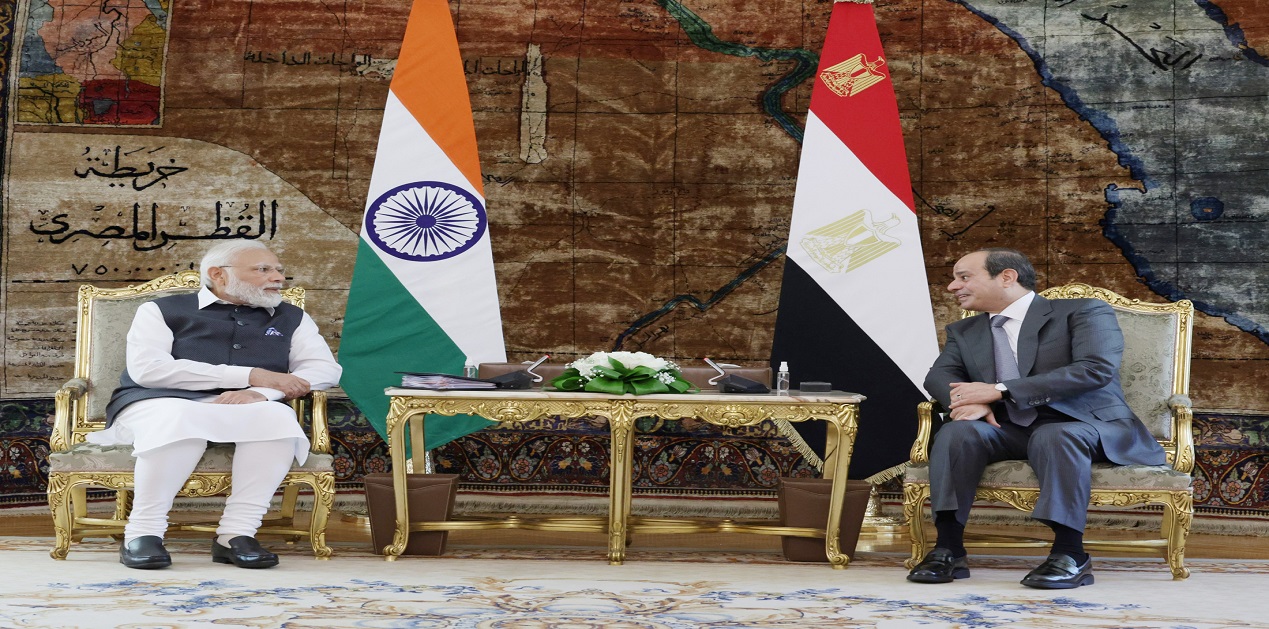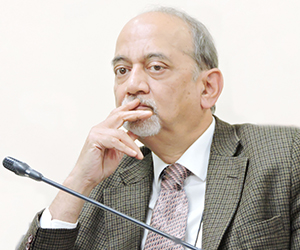Prime Minister Modi concluded a two-day visit to Egypt on 24-25th June. The last visit at the prime minister’s level from India to that country took place 26 years ago in 1997. The visit is an important initiative to fill up the hiatus in engagement with an important regional power. Egypt is the largest country in the Arab world. It has long remained the fulcrum of Middle East politics. Earlier this year, President Sisi visited India during the 26th January celebration when he was the chief guest. In a sign of the importance attached by Egypt to the visit, PM was received by the Egyptian Prime Minister Mostafa Madbouli on arrival at the airport. He met President Fattah El-Sisi the next day. PM in his tweet said that his ‘visit to Egypt was a historic one. It will add renewed vigour to India-Egypt relations and will benefit people of our nations.’[1] The two sides signed an agreement to upgrade their ties to a strategic partnership.[2]
Egypt has a unique geographical location. It is part of the Arab world as well as Africa. It was the founder of the Arab League. It plays an important role in the deliberations of the African Union also. The Suez Canal remains one of the most important arteries of world trade. The country’s strategic importance cannot be denied. Peace in the Middle East is not possible without Egypt. It remains the most important Arab military power. In the case of conflagration in the Gaza Strip, the US has sought Egyptian intervention in the past.
India and Egypt are one of the oldest civilizations in the world. Both went through a phase of foreign rule. India was ruled directly by the British; Egypt was controlled indirectly by them since the latter half of the 19th century. The contact at the State level may have been infrequent or even absent for long periods. But the tradition of interaction at the people-to-people level has continued unbroken. This is reflected in the language and culture. Maths is called ‘Handasa’’ in Arabic. This is derived from ‘Hind’. The knowledge of algebra went from India to Egypt and was dispersed to the Western world from there. Many common words in Hindi or Urdu have Arabic roots. This includes ‘ishq’ (love), ‘maut’ (death), ‘bus’ (enough), and ‘lekin’ (but). Bollywood movies are popular. Increasingly, Yoga has found a niche in the Arab world. This goes beyond Egypt.
Modi Ji’s visit was full of symbolism. He visited the War Memorial at Heliopolis to pay tribute to the Indian soldiers who fought and sacrificed their lives in the two World Wars. They were fighting as part of the British Indian Army. They took part in some of the fiercest battles of the Second World War. Their graves are maintained by the Commonwealth War Graves Commission. It was a fitting tribute to the bravery of the unknown Indian soldiers that the Prime Minister of free India visited the site.
President Abdul Fattah Al-Sissi conferred on Prime Minister Modi the Order of the Nile. This is Egypt’s highest civilian award.[3] There is an impressive list of previous winners of the award. This includes President Tito, President Jimmy Carter, Emperor Akihito of Japan, King Saud Bin Abdul Aziz, and Haitham bin Tariq, Sultan of Oman earlier this year. [4] The Nile has a special place in Egypt’s history and culture. The historian Herodotus said Egypt is the gift of the Nile.
Prime Minister met the grand Mufti of Egypt, Shawky Ibrahim Abdel-Karim Allam. Grand Mufti is the highest religious leader of the country. He said Modi Ji reflects ‘a wise leadership for a big country like India.’[5] Modi Ji also visited Al-Hakin Mosque in Cairo. This mosque belongs to Shia Ismaili Order. Their roots go back to the Fatmid period of Egyptian history when Egypt was the seat of the caliphate. The Ismaeli Bohras are a prosperous trading community and have a strong presence in India. Modi Ji had an interaction with the Indian community soon after his arrival.
Both Egypt and India are plural societies. Egypt has a 15% Coptic Christian minority. Egypt lies at the crossroads of invasion since the Roman period. There has been an overlay of different cultures and civilizations. Napoleon’s conquest opened the doors for the study of Egyptology. The strength of Egyptian culture has been assimilation. The two countries have faced similar challenges from terrorism and extremism. President Sadat was assassinated. India has lost two prime ministers to terrorist violence. Egypt has taken strong steps to counter-terrorism.
Indian exports to Egypt in 2022-23 were $ 4.109 billion. India’s imports from Egypt during this period were $ 1.951 billion.[6] The total trade of $ 6.06 billion does not represent the true potential of the two countries. There is scope for Indian defense exports to that country. The target is to boost trade to $ 12 billion in five years. This is doable. However, the availability of foreign exchange will be a problem. Egypt is going through a difficult economic situation and has received IMF assistance. The country has received $ 3 billion in assistance over 46 months’ period from IMF’s Extended Arrangement under Extended Fund Facility.[7] The IMF Staff Country Report mentions that the country’s economic growth had begun to recover after Covid during FY 2021/22. The Ukraine war increased the strain on the Egyptian economy. The country depends on Russia and Ukraine for wheat and tourism. There were ‘capital and large reserves losses while high commodity prices led to rising inflation.’[8]
The high inflation and foreign exchange crisis will work against an increase in trade. Barter trade is a possibility. Egypt produces some of the finest long-staple cotton. It also has discovered large gas reserves in its Exclusive Economic Zone in the Mediterranean. Though it is not possible to bring gas, it should be possible to import gas-based products including petrochemicals and fertilizer. Egypt is part of the African Union (AU). The AU Continental Free Trade Area Agreement has laid the foundations of an African market. Setting up an industry in Egypt could provide Indian companies access to a wider African market.
India and Egypt have signed three MOUs, apart from the agreement to upgrade their ties to a strategic level. These MOUs are for cooperation in agriculture, archaeology and antiquities, and competition law. There are possibilities of Indian investment in Suez Canal Economic Zone. There are ‘very strong possibilities’ of investment and technology partnership in the field of green hydrogen.[9]
India had supported Egypt during the Suez Crisis and the Anglo-French invasion. India also provided a contingent for UN Emergency Force in Sinai. There are possibilities of cooperation in the multilateral fora in future too. Egypt hosted COP 27 Conference at Sharm El-Sheikh last year. Egypt is a candidate for BRICS membership. Foreign Secretary Kwatra said that ‘We are looking actively at all the applications, naturally including of a very friendly and strategic partner like Egypt.’ [10]
Cairo was my first posting after joining the Indian Foreign Service. I was sent to learn Arabic at the American University in Cairo. The University campus was located at Midan-Al-Tehrir. I was struck by the warmth of the Egyptian people. There were occasions when complete strangers went out of their way to help me. The Tea Board at the time used to run a restaurant at Sharia TalatHarb, which was a prominent meeting place for Egyptian intellectuals, and finds a mention in the novel of Naguib Mahfouz, who won the Nobel Prize for literature.
References
[1]https://twitter.com/narendramodi/status/1672963932091453441
[2]Hindustan Times, Modi meets Egypt’s Sisi to deepen bilateral ties. 26.6.2023.
[3]www.mea.gov.in
[4]Wikipedia
[5]Modi, Egypt’s grant mufti discuss social, religious harmony, PTI, www.rediff.com
[6]Department of Commerce, Export Import Data Bank
[7]https://www.imf.org -Egypt
[8]https://www.imf.org -Egypt
[9]Hindustan Times, Modi meets Egypt’s Sisi to deepen bilateral ties. 26.6.2023.
[10]Hindustan Times, Modi meets Egypt’s Sisi to deepen bilateral ties. 26.6.2023.
Image Source: https://www.pmindia.gov.in/en/image-gallery/










Post new comment